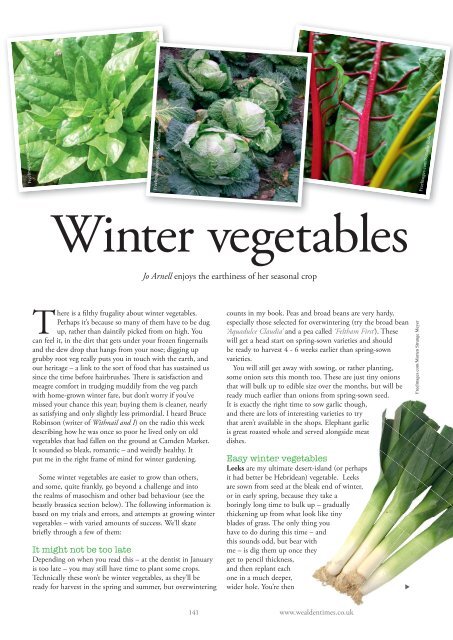Wealden Times | WT165 | November 2015 | Gift supplement inside
Wealden Times - The lifestyle magazine for the Weald
Wealden Times - The lifestyle magazine for the Weald
Create successful ePaper yourself
Turn your PDF publications into a flip-book with our unique Google optimized e-Paper software.
FreeImages.com/Samantha Ji<br />
FreeImages.com/Ibon San Martin<br />
FreeImages.com/Nathalie Dulex<br />
Winter vegetables<br />
Jo Arnell enjoys the earthiness of her seasonal crop<br />
There is a filthy frugality about winter vegetables.<br />
Perhaps it’s because so many of them have to be dug<br />
up, rather than daintily picked from on high. You<br />
can feel it, in the dirt that gets under your frozen fingernails<br />
and the dew drop that hangs from your nose; digging up<br />
grubby root veg really puts you in touch with the earth, and<br />
our heritage – a link to the sort of food that has sustained us<br />
since the time before hairbrushes. There is satisfaction and<br />
meagre comfort in trudging muddily from the veg patch<br />
with home-grown winter fare, but don’t worry if you’ve<br />
missed your chance this year; buying them is cleaner, nearly<br />
as satisfying and only slightly less primordial. I heard Bruce<br />
Robinson (writer of Withnail and I) on the radio this week<br />
describing how he was once so poor he lived only on old<br />
vegetables that had fallen on the ground at Camden Market.<br />
It sounded so bleak, romantic – and weirdly healthy. It<br />
put me in the right frame of mind for winter gardening.<br />
Some winter vegetables are easier to grow than others,<br />
and some, quite frankly, go beyond a challenge and into<br />
the realms of masochism and other bad behaviour (see the<br />
beastly brassica section below). The following information is<br />
based on my trials and errors, and attempts at growing winter<br />
vegetables – with varied amounts of success. We’ll skate<br />
briefly through a few of them:<br />
It might not be too late<br />
Depending on when you read this – at the dentist in January<br />
is too late – you may still have time to plant some crops.<br />
Technically these won’t be winter vegetables, as they’ll be<br />
ready for harvest in the spring and summer, but overwintering<br />
counts in my book. Peas and broad beans are very hardy,<br />
especially those selected for overwintering (try the broad bean<br />
‘Aquadulce Claudia’ and a pea called ‘Feltham First’). These<br />
will get a head start on spring-sown varieties and should<br />
be ready to harvest 4 - 6 weeks earlier than spring-sown<br />
varieties.<br />
You will still get away with sowing, or rather planting,<br />
some onion sets this month too. These are just tiny onions<br />
that will bulk up to edible size over the months, but will be<br />
ready much earlier than onions from spring-sown seed.<br />
It is exactly the right time to sow garlic though,<br />
and there are lots of interesting varieties to try<br />
that aren’t available in the shops. Elephant garlic<br />
is great roasted whole and served alongside meat<br />
dishes.<br />
Easy winter vegetables<br />
Leeks are my ultimate desert-island (or perhaps<br />
it had better be Hebridean) vegetable. Leeks<br />
are sown from seed at the bleak end of winter,<br />
or in early spring, because they take a<br />
boringly long time to bulk up – gradually<br />
thickening up from what look like tiny<br />
blades of grass. The only thing you<br />
have to do during this time – and<br />
this sounds odd, but bear with<br />
me – is dig them up once they<br />
get to pencil thickness,<br />
and then replant each<br />
one in a much deeper,<br />
wider hole. You’re then<br />
<br />
FreeImages.com/Morten Strunge Meyer<br />
141 www.wealdentimes.co.uk


















